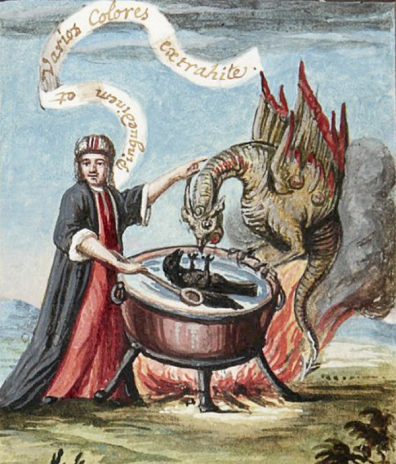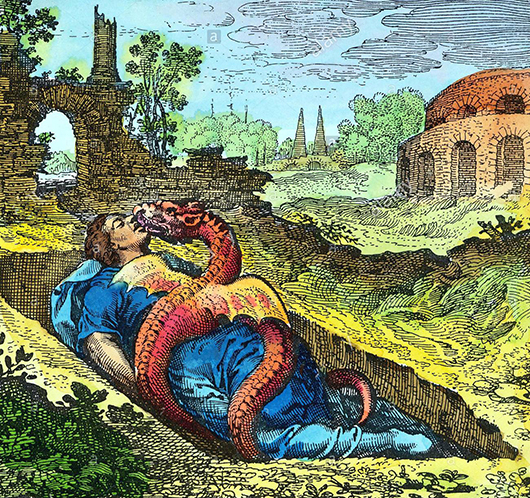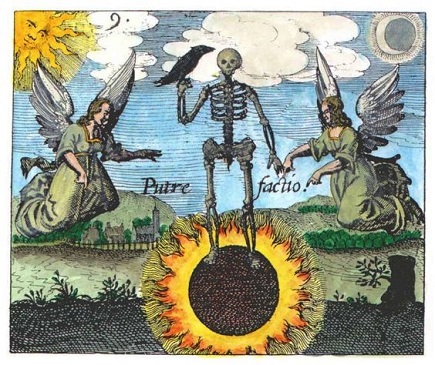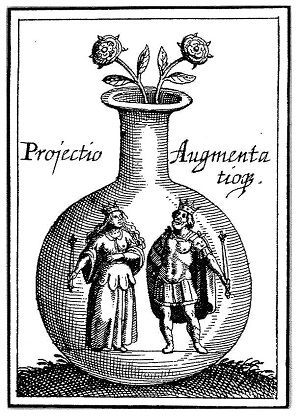I.
From Vox: Solving The Mystery Of The Internet’s Most Beloved And Notorious Fanfic. The fanfic is “My Immortal”, a Harry Potter story so famous that it has its own Wikipedia page, and articles about it in Slate, Buzzfeed, and The Guardian.
It’s famous for being really, really bad. Spectacularly bad. Worse than it should be possible for anything to be. You wouldn’t think you could get The Guardian to write an article about how bad your fanfiction was, but here we are. Everyone agrees that it must have taken a genius to make something so awful, but until recently nobody knew who had authored the pseudonymous work. The Vox article investigates and finds it was probably small-time author Theresa Christodoupolos, who goes by the pen name Rose Christo.
But this leaves other mysteries unresolved. Like: what is going on with it? Its plot makes little sense – characters appear, disappear, change names, and merge into one another with no particular pattern. Even its language is fluid, somewhere between misspelled English and a gibberish that can at best produce associations suggestive of English words.
All these features are unusual in a modern fanfiction. But they’re typical of alchemical texts, which are usually written in a layer of dense allegory. Might this shed more light on My Immortal? After spending way too long investigating this, I find strong evidence in favor. My Immortal is a description of the Great Work of alchemy. Its otherwise-inscrutable symbolism is a combination of three traditions: the medieval opus, the 17th century Rosicrucians, and the native German traditions encoded in Goethe’s Faust. We’ll start by going over these traditions, then delve into the text to unveil the hidden meaning.
First Source: The Medieval Opus
Medieval alchemy centered around the Great Work, or magnum opus, of creating the Philosopher’s Stone. The Stone is supposedly a substance that can transmute lead into gold and grant immortality. But scholars since Jung have also interpreted the opus symbolically, as a process of spiritual transformation. In this reading, the chemical processes are a metaphor for psychological processes, and the creation of the Stone represents the discovery of the true Self, similar to the Christian gnosis or Buddhist enlightenment. Descriptions of the opus tend to describe it as taking place in a series of stages, usually three: nigredo (blackness), albedo (whiteness), and rubedo (redness).
In the first stage (nigredo, “blackness”), you start with some kind of base matter. In the chemical allegory, this is usually lead. In the psychological version, this is the normal mental state, with all of its hangups and uncertainties. The seeker at this stage is symbolized by the raven, blackest of animals. He (the medieval system assumes a male seeker) must begin by confronting his unconscious mind, which takes the form of a dragon. The unconscious is full of bizarre and shameful repressed material, and the seeker’s instinct is to run away. Instead, he must slay the dragon, at which point the dragon rises again as an ally. The seeker then unites with the unconscious in the first “chemical wedding”, ending in a sudden revelation of blinding whiteness – the second stage of the Work.
In the second stage (albedo, “whiteness”), the base matter must be cleansed of its impurities. The seeker is analogized to a child in a baptismal font, or bathing in a stream, or [any of several other water metaphors]. Eventually it begins to shine with its own inner silvery-white light. When the dross has been cleared away, the seeker encounters a second representation of his feminine principle. He unites with the feminine principle in the second “chemical wedding”, and finally see his True Self as it really is.
In the third stage (rubedo, “redness”), the seeker has already discovered his True Self as a sort of distant guiding star, but has yet to relate it to the rest of his life or the everyday world. The otherworldy True Self must be united with the seeker’s worldly personality in the final and greatest alchemical wedding, often called the Marriage of the Sun and Moon, or the Marriage of the King and Queen, or [several other flowery metaphors], which joins all opposites into a final cataclysmic union – the Philosopher’s Stone. When this stage ends, the seeker is once again an ordinary person interacting with the ordinary earthly world, but now in a way fully integrated with his true Self. In some traditions, the work is cyclic, and the seeker begins again at the nigredo stage.
Some of this is already in canonical Harry Potter – the first book in the series was originally called Harry Potter and the Philosopher’s Stone, and Rowling included a few alchemical “easter eggs”. In particular, she includes characters named after two of the three stages: Albus Dumbledore (= albedo) and Rubeus Hagrid (= rubedo). There is no character representing the blackness stage, probably because calling somebody “Nigerus” would be Problematic.
In order to turn Rowling’s half-assed name-dropping into a true alchemical allegory, My Immortal has to introduce the missing character with a blackness-themed name. Accordingly, its first sentence starts “Hi my name is Ebony Dark’ness Dementia Raven Way”.
Second Source: The Rosicrucian Writings
These were a series of anonymous pamphlets that took Germany by storm in the early 17th century. They purported to reveal the existence of a secret brotherhood of alchemists, the Rosicrucians, who had discovered vast mystical secrets and were going to disclose them any day now. According to the pamphlets, they had been founded by a hero-sage, Christian Rosenkreutz, who had traveled the world seeking wisdom. But Rosenkreutz was a bit too allegorical for anyone to think he was a real person. His last name was German for “Rosy Cross”, referring to a long tradition of alchemical symbolism in which one produced the Stone by uniting the Rose (the feminine? the spirit? the consciousness?) and the Cross (the masculine? the material world? the body?). The symbolism was a bit unclear, but it caught on, and soon all sorts of mystical groups were using a rose cross as their logo and claiming to be Rosicrucian-inspired.

The most famous Rosicrucian work was The Chymical Wedding Of Christian Rosenkreutz, which purports to be a story about Rosenkreutz getting an invitation to go to a castle for a wedding. But this is just the frame story for throwing a metric ton of inscrutable symbolism at the reader, as Christian successively encounters candle-lighting virgins, golden scales, white serpents, and a bunch of gates and towers. Everybody assumed there were deep mystical secrets contained in this, probably related to the alchemical wedding necessary to achieve the Philosopher’s Stone.
My Immortal wears its Rosicrucian themes on its sleeve. Most obviously, its author uses the not-exactly-subtle pen name “Rose Christo”. But also, the third sentence of the introduction is just “MCR ROX!” A quick check at the My Immortal Wiki tells us that MCR is supposed to be an abbreviation for “My Chemical Romance”.
I maintain that if you are writing a fanfiction of a book about the Philosopher’s Stone, and you use the pen name “Rose Christo”, and you reference a “chemical romance” in the third sentence, you know exactly what you are doing. You are not even being subtle. My Immortal is in part a modern retelling of The Chymical Wedding of Christian Rosenkreutz.
Third Source: Goethe’s Faust II
You know the story. A great alchemist, frustrated by the limitations of his mortal faculties, makes a deal with the Devil. The Devil will give the alchemist anything he desires. In exchange, if the alchemist ever knows a single moment of perfect happiness, he will die and the Devil will get his soul. Maybe you even know the followup: he covets an innocent maiden, Gretchen, and with the help of the Devil he gradually corrupts her until she chooses death over a life of sin.
All that is Faust Part I. Later in life, Goethe wrote the much weirder Faust Part II. A German scholar assures me that “nobody has any idea what it’s about”, except that it is definitely an alchemical metaphor in some way.
A brief synopsis: Faust, thanks to his pact with the Devil, has now become a powerful sorcerer and respected statesman. He decides that a cool thing to do would be to marry Helen of Troy (here called by her German name “Helena”) the most beautiful woman in history. The Devil (with the help of the Sibyl) helps him time-travel back to ancient Greece, where he meets Helena, seduces her, and brings her back to his own time. They have a child together, but the child dies, and in grief Helena departs Faust for the Greek underworld. Faust devotes himself to a different project – raising a new country out of the sea, which he will govern. The country-raising goes really well, and looking upon his new territory, Faust accidentally feels a single moment of perfect happiness. He dies, and the Devil takes his soul and drags him to Hell. Then a choir of angels show up and distract the Devil. While he is distracted, they carry Faust up to Heaven. There he meets all the women in his life – eg Gretchen and Helena – as well as the Virgin Mary. All of them are revealed to be aspects of the Eternal Feminine within himself (or something), and by recognizing this, he is redeemed and found worthy of salvation. The end.
My Immortal is full of symbolic wordplay (for example, did you catch that “MCR ROX” references not just the Chemical Wedding but also its end result, the Stone?) When it mentions that a character is Goth, or seems Goth, or does something in a Goth way, this is often a visual pun (Goth = Goethe) telling us that the scene has a parallel in Faust. We’ll go over some examples later.
Overall Structure
The canonical version of My Immortal is separated into two books of 22 chapters each. In occultism, 22 is the number of completion, especially in Kabbalah (where there are 22 letters of the Hebrew alphabet, 22 generations from Adam to Israel, and 22 paths on the Tree of Life), and Tarot (where there are 22 Major Arcana). So we can think of the book, like the Opus, as a double-traversal of the Tree of Life – first going up from Earth to Heaven, then returning to Earth again.
The medieval and Rosicrucian themes are mostly concentrated in the first half of the text, and consist of a series of thwarted traversals of the alchemical path. At the end of Part 1, a final successful traversal is completed. In Part 2, we segue to a scene-by-scene identity with Part 2 of Faust. More specifically:
Chapter 1 – 5: Alchemical Path 1, nigredo, albedo. Purification fails, seeker sinks back into prima materia.
Chapters 6 – 18: Alchemical Path 2, nigredo, albedo, partial rubedo. Second alchemical wedding fails, seeker sinks back into prima materia
Chapters 18 – 22: Alchemical Path 3, nigredo, albedo, rubedo. Second alchemical wedding partly completed, seeker remains in limbo state.
Chapters 22 – 39: Equivalent to Faust, Act II, Scene 3.
Chapters 40 – 44. Equivalent to Faust, Act II, Scene 5. Third alchemical wedding succeeds, Stone attained.
I realize these are very odd claims, so I want to demonstrate the flow of symbolism in each of these and compare it to that used in more traditional alchemical texts.
II.
Chapters 1 – 5: First Path
In his papers on alchemy, Carl Jung writes “Great importance was attached to the blackness as the starting point of the Work”. The first sentence of My Immortal begins “Hi my name is Ebony Dark’ness Dementia Raven Way”.
But Ebony’s name isn’t just blackness. It’s a combination of all the different symbols of the nigredo stage. Let’s look at the rest of the Jung quote:
Great importance was attached to the blackness as the starting point of the Work. Generally it was called the “Raven”. In our context the interpretation of the nigredo as terra (earth) is significant. Like the anima media natura or Wisdom, earth is in principle feminine. It is the earth which, in Genesis, appeared out of the waters, but it is also the terra damnata.
I’ve bolded the relevant points. Unlike the albedo and rubedo characters, the nigredo character must be feminine. Her name references the Raven. More speculatively, damnata = Dementia? I think plausibly true. Her name is just a bunch of nigredo symbols strung together.
The nigredo stage begins with a black substance (sometimes identified with lead, the starting point for the transmutation) being placed in a vessel called “the coffin”. From Landauer & Barnes (2011):
The alchemists used a number of different vessels in their work and these vessels – variously known as alembic, coffin, egg, sphere, prison, and womb – particular to stages in the alchemical process. During the blackness of the putrefying Mortificatio, the vessel was represented as a coffin or prison
Each of the three paths in Part I of My Immortal begins with Ebony waking up in a coffin. For example Chapter 2: “I got out of my coffin and took of my giant MCR t-shirt which I used for pajamas”. Remember, MCR means “my chemical romance” and when it appears it usually tells us that we are getting an alchemical analogy.
The black substance in the coffin must then undergo a series of reactions, usually symbolized as interactions between a raven and dragon. Sometimes the raven and dragon are the same entity; other times they are different entities that must confront each other and unite. For example, from the Aurelia Occultae Philosophorum:
I am an infirm and weak old man, surnamed the dragon; therefore am I shut up in a cave, that I may become ransomed by the kingly crown. A fiery sword inflicts great torments on me; death makes weak my flesh and bones. My soul and my spirit depart; a terrible poison, I am likened to the black raven, for that is the wages of sin.
In Jung’s more psychological version, the raven is the seeker and the dragon is the seeker’s unconscious mind. The seeker must begin by confronting his unconscious and all the repressed material therein.

A typical alchemical illustration with raven and dragon. This one isn’t going so well for the raven.
In the first chapter of My Immortal, a raven-named character meets a dragon-named character:
“Hey Ebony!” shouted a voice. I looked up. It was…. Draco Malfoy!
“What’s up Draco?” I asked.
“Nothing.” he said shyly.
But then, I heard my friends call me and I had to go away.
The encounter with the unconscious begins the process of mortificatio. This is cognate with the English word “mortify”, and with good reason – the unconscious is full of all of our deepest and most shameful repressed desires. Herzer and Gillabel describe it like so:
In alchemy the dragon corresponds closely with what Jung called the Shadow. The Shadow is the name for a collection of characteristics and impulses which could be conscious, but which are denied. At the same time we recognize and see them in other people. Some examples of the Shadow are: egotism, laziness, intrigues, unreal fantasies, indifference, or being obsessed by money and possessions. The Shadow is the inferior being in us that desires what we do not allow ourselves because it is uncivilized, because it is incompatible with society’s rules and with the image of our ideal personality. It is all that what we are ashamed of.
When Ebony encounters Draco, she feels shame:
“OMFG, I saw you talking to Draco Malfoy yesterday!” [Willow] said excitedly.
“Yeah? So?” I said, blushing.
“Do you like Draco?” she asked as we went out of the Slytherin common room and into the Great Hall.
“No I so fucking don’t!” I shouted.
“Yeah right!” she exclaimed.
The work of the nigredo stage is to transmute this shame into acceptance and even love. Some sources describe this as slaying the dragon – but after being slain, the dragon rises again in a perfected form. Once the seeker is fully comfortable with their dragon, self and unconscious unite in the first alchemical wedding.
Just then, Draco walked up to me.
“Hi.” he said.
“Hi.” I replied flirtily.
“Guess what.” he said.
“What?” I asked.
“Well, Good Charlotte are having a concert in Hogsmeade.” he told me.
“Oh. My. Fucking. God!” I screamed. I love GC. They are my favorite band, besides MCR.
“Well…. do you want to go with me?” he asked.
I gasped.
Draco invites Ebony on a date, where they will see a band Ebony compares to My Chemical Romance. In general, concert dates in My Immortal represent alchemical weddings. This particular concert is the wedding at the end of the first stage. We know this because the story describes Ebony’s clothing in detail at several points, and it is always some combination of black, white, and red. The particular colors at any given time indicate the stage of the Work being represented. In this case, when dressing up for the concert, Ebony says:”I painted my nails black and put on TONS of black eyeliner. Then I put on some black lipstick.” The only color is black – so she is still entirely in the nigredo stage.
At the end of the concert/date/wedding, Draco and Ebony go to the Forbidden Forest and have sex, representing the union of Ebony and her unconscious. This signals the end of the nigredo stage and the beginning of albedo.
Then he put his thingie into my you-know-what and we did it for the first time.
“Oh! Oh! Oh! ” I screamed. I was beginning to get an orgasm. We started to kiss everywhere and my pale body became all warm. And then….
“WHAT THE HELL ARE YOU DOING YOU MOTHERFUKERS!”
It was…………………………………………………….Dumbledore!
Almost all descriptions of the beginning of albedo emphasize its suddenness. Jung writes that “the nigredo gives way to the albedo…the ever deepening descent into the unconscious suddenly becomes illumination from above”. Remember that Albus Dumbledore is the Harry Potter character representing albedo, even as Ebony represents nigredo. So as Ebony has sex with Draco (deepening descent into the unconscious), suddenly she sees Dumbledore standing over her.

The part where the seeker has sex with the dragon is canon.
But there are signs that the transition is not complete. Dumbledore interrupts her before she can have an orgasm; the union has been only partially consummated. And there are 21 marks between “was” and “Dumbledore” (20 ellipses plus one lone period), which is one short of 22, the mystical number of completion.
As we will see later, Ebony skipped a step – she did not kill the dragon before uniting with it. Therefore, the purification of the albedo appears as the hostile interference of a superego perceived as alien, rather than as a deliberate cleansing from within. Dumbledore admonishes Ebony for her disgusting sexual act and forces her and Draco to separate, ending the path.
Chapter 6 begins “The next day I woke up in my coffin. I put on a black miniskirt that was all ripped around the end and a matching top.” Ebony is back in the coffin, dressed in all black. She has returned to the very beginning of the Work.
Chapters 6 – 18: Second Path
In this section, Ebony retraces her steps. She meets Draco again. They have sex again. But this time, Ebony learns that Draco is in love with Harry Potter (nicknamed “Vampire” in this work), and breaks up with him angrily. This causes Draco to commit suicide – she has slain the dragon. Later, she learns that Draco has inexplicably come back to life (as the alchemical symbolism insists must happen) and is being held hostage in Voldemort’s lair. Recall again the description from Aurelia Occultae Philosophorum: “I am an infirm and weak old man, surnamed the dragon; therefore am I shut up in a cave, that I may become ransomed by the kingly crown”. She rescues Draco and has sex with him again. The path has been completed in full.
But she actually reaches the albedo stage earlier than that – at the moment Draco dies. Let’s go through the symbolism piece by piece:
We practiced for one more hour. Then suddenly Dumbeldore walked in angrily! His eyes were all fiery and I knew this time it wasn’t cause he had a headache.
“What have you done!” He started to cry wisely. (c dats basically nut swering and dis time he wuz relly upset n u wil c y) “Ebony Draco has been found in his room. He committed suicide by slitting his wrists.” […]
I started crying tears of blood and then I slit both of my wrists. They got all over my clothes so I took them off and jumped into the bath angrily while I put on a Linkin Park song at full volume. […]
I got out of the bathtub and put on a black low-cut dress with lace all over it sandly.
Dumbledore appears, again “suddenly”. He gives her the news of Draco’s death. Then Ebony slits her wrists. Compare to Hamilton’s The Alchemical Process Of Transformation:
Completion of the first stage is now experienced as a death, which is in fact a complete letting go of the old sense of self that was identified unconsciously with the earth nature. Images of fire and burning often accompany the images of death and endings. Now we are ready to enter the second stage.
Did you catch how Dumbledore’s “eyes were all fiery”?
Just as the nigredo stage should begin in a coffin, so the albedo stage should begin in a baptismal font. But a bathtub is a perfectly serviceable replacement – in fact, a raven in a bathtub is the same image used in this part of The Chymical Wedding Of Christian Rosenkreutz. A magic egg hatches a black bird, and then:
A bath colored with fine white powder had been prepared for the bird, which enjoyed bathing in it until the lamps placed beneath the bath caused the water to become uncomfortably warm. When the heat had removed all the bird’s feathers it was taken out.
When Ebony gets out of the bath, she puts on a “dress with lace all over it” – the lace is presumably white, so the dress is black-and-white, signifying that she has now attained both the nigredo and the albedo stages. Her current task in the Work is to purify herself, see through the falsehoods of the ego, and behold her true Self.
Ebony notices that Professors Snape and Lupin have been videotaping her naked in the bath. She accuses them of pedophilia and then “I took my gun and shot Snape and Loopin a gazillion times and they both started screaming and the camera broke.” This is the purification and the confrontation with the ego. The ego is analogized to a voyeur with a camera, recording everything we do, showing us our own nakedness. Ebony shoots the camera and breaks it. Compare to Dogen’s analogy of enlightenment to breaking a mirror.
Ebony’s next step should be a second alchemical wedding, this time with her animus.
The medieval alchemists (writing for their male readers) spoke of the anima figure, the feminine archetype within every man. The anima can appear as a hideous old hag, but if accepted, turns into a supernaturally beautiful young woman, the intended bride of the second alchemical wedding. Jung adds that every woman has an equivalent animus, the male archetype. Presumably he too starts out appearing ugly, but if accepted he transforms into a handsome young man.
Ebony’s dual animus is Hagrid on the one side, and Harry “Vampire” Potter on the other. She constantly conflates these two characters in bizarre ways; we readers are supposed to understand that they represent different facets of the same archetype, which Ebony cannot integrate. For example, when Harry comes in in Chapter 12, Ebony says “I THOUGHT IT WAS HAIRgrid but it was Vampire.” Later, she will constantly refer to them by a combined names like “Hairgrid”, “Hargrid”, or even “Hahrid”.
Ebony externalizes the negative aspects of her animus as Hagrid (note the “Hag”, which she cannot bring herself to say), canonically the ugliest person at Hogwarts. Hagrid is everything she hates: prep, not Goth, and “fucked up”. She externalizes the alluring aspects as Harry, canonically rich, famous, and attractive. Ever since Twilight, the archetypal animus figure – the alluring, supernaturally beautiful, mysterious male – has been the vampire, so Harry becomes “Harry ‘Vampire’ Potter”.
There’s more. In My Immortal, Harry has a pentagram-shaped scar. The pentagram is an alchemical symbol, but there’s some evidence that it’s not what’s really involved here. Earlier in the story, Ebony describes Draco as “wearing white foundation and messy eyeliner kind of like a pentagram (geddit) between Joel Madden and Gerard Way.” Later she uses the same device: “My voice sounded lik a pentagram betwen Amy Lee and a gurl version of Gerard Woy”. I think we are supposed to infer that, as a Satanist, she is uncomfortable with naming the Christian symbol (the cross) and so replaces it with a Satanist symbol (the pentagram). So plausibly Harry has a cross-shaped scar.
This is significant because a few paragraphs later, when Ebony is in the hospital after her wrist-slitting injury, Hagrid comes and offers Ebony a bouquet of roses. Harry (the cross-bearer) is the same person as Hagrid (the rose-bearer). Ebony needs to recognize them as different aspects of the same animus, the united Rosy Cross, so she can behold her True Self. Let’s see how she does:
Hargrid came into my hospital bed holding a bouquet of pink roses.
“Enoby I need to tell u somethnig.” he said in a v. serious voice, giving me the roses.
“Fuck off.” I told him. “You know I fucking hate the color pink anyway, and I don’t like fucked up preps like you.” I snapped. Hargrid had been mean to me before for being gottik.
“No Enoby.” Hargrid says. “Those are not roses.”…He suddenly looked at them with an evil look in his eye and muttered Well If you wanted Honesty that’s all you haD TO SAY! .
“That’s not a spell that’s an MCR song.” I corrected him wisely.
“I know, I was just warming up my vocal cordes.” Then he screamed. “Petulus merengo mi kremicli romacio(4 all u cool goffic mcr fans out, there, that is a tribute! specially for raven I love you girl!)imo noto okayo!”
And then the roses turned into a huge black flame floating in the middle of the air. And it was black.

Pictured: Ebony Raven and “a huge black flame floating in the middle of the air.”
If Ebony had accepted Hagrid, he would have turned into Harry, united with her for the second alchemical wedding, and revealed her True Self. Instead, he produces the sign of black fire. The black sun (sol niger) is one of the most ominous symbols in alchemy. Its various connotations are too complicated to explain here (see The Black Sun: The Alchemy And Art Of Darkness for a thorough review) but they are generally highly negative. “The sol niger [is] Saturn, is the shadow of the sun, the sun without justice, which is death for the living.”
Yet at times the Black Sun can be useful; suffering itself becomes a catalyst for transformation. This seems to be one of those times. Ebony is shocked into acknowledging Hagrid (“Now I knew he wasn’t a prep. “OK I believe you now'”)
Is this good enough for her to find her True Self? Going back to the text:
And then the roses turned into a huge black flame floating in the middle of the air. And it was black. Now I knew he wasn’t a prep.
“OK I believe you now wtf is Drako?”
Hairgrid rolled his eyes. I looked into the balls of flame but I could c nothing.
“U c, Enobby,” Dumblydore said, watching the two of us watching the flame. “2 c wht iz n da flmes(HAHA U REVIEWRS FLAMES GEDDIT) u mst find urslf 1st, k?”
“I HAVE FOUND MYSELF OK YOU MEAN OLD MAN!” Hargrid yelled.
Dumbledore tells Ebony that she needs to find herself. But it is Hagrid who retorts that he has found herself. I take this to mean she has failed to integrate with Hagrid; he remains a psychopomp figure, containing the knowledge of Ebony’s Self but unable to transmit it to her.
Nevertheless, something has been gained, because:
Anyway when I got better I went upstairs and put on a black leather minidress that was all ripped on the ends with lace on it. There was some corset stuff on the front. Then I put on black fishnets and black high-heeled boots with pictures of Billie Joe Armstrong on them. I put my hair all out around me so I looked like Samara from the Ring (if u don’t know who she iz ur a prep so fuk off!) and I put on blood-red lipstick, black eyeliner and black lip gloss.
Ebony is still dressed mostly in black, but has a tiny bit of white (the lace) and the slightest bit of red (the lipstick). She is basically back in nigredo now, with only hints of the other stages she has tried to attain.
All of this catches up with her in the total fuckup of an attempted alchemical wedding that follows. If she is actually in albedo, she should be uniting with her animus. If she is actually in rubedo, she should be uniting with God. Instead, it’s just Draco again.
Then I saw a poster saying that MCR would have a concert in Hogsmede right then. We [Ebony and Draco] looked at each other all shocked and then we went 2gether.
There is a long list of Ebony and Draco’s preparations for the concert (cf. the preparation chapters of The Chymical Wedding Of Christian Rosenkreutz, and note the part where Ebony calls Draco “Christian” at the beginning of Chapter 16).

The original chemical romance.
But the actual concert itself is a disaster:
Gerard was da sexiest guy eva! He locked even sexier den he did in pix. He had long raven blak hair n piercing blue eyes. He wuz really skinny and he had n amazing ethnic voice. We moshed 2 Helena and sum odder songz. Sudenly Gerard polled of his mask. So did the other membez. I gasped. It wasn’t Gerard at all! It was an ugly preppy man wif no nose and red eyes… Every1 ran away but me and Draco. Draco and I came. It was…….Vlodemort and da Death Deelers!
The supposed concert/date/wedding proves utterly disastrous – “My Chemical Romance” is just Voldemort wearing a mask. Draco and Ebony flee. Chapter 18 begins:
I woke up the next day in my coffin. I walked out of it and put on some black eyeliner, black eyesharrow, blood-bed lipstick and a black really low-cut leather dress that was all ripped and in stripes so you could see my belly
She is back in the coffin, dressed in all black (she tries to say the word “red”, but fails). She has lost even the hints of previous stages.
Chapters 18 – 22: Third Path
At the beginning of Chapter 18, Ebony is in her coffin, wearing all black. She immediately meets up with Draco (fourth paragraph of Chapter 18). Immediately after this, Dumbledore suddenly appears (fifth paragraph of Chapter 18). There is purification by water (ninth paragraph of Chapter 19, “I ran to the bathroom”). Hagrid suddenly apperas (tenth paragraph of Chapter 19, “Suddenly Hargrid came. He had appearated.”) Hagrid says there is a My Chemical Romance concert that night (thirteenth paragraph of Chapter 19). We have speed-retraced the entire alchemical path accomplished previously.
But this time, Ebony accepts Hagrid by recognizing him as the keeper of the secret of the alchemical wedding (“’U no who MCR r!’ I gasped.”) And so at the concert, the other half of the animus appears to Ebony in a a merciful form (“Vampire and I began 2 make out, moshing to the muzik.”) Instead of going back to her coffin alone, “we went back to our coffins frenching each other…on the gothic red bed together”. Notice that instead of being in a black coffin, they are now in a red bed, the symbol of the bridal chamber after the second alchemical wedding:
Take the fayer Roses, white and red
And joyne them well in won bed.
This ends the first traversal of the Tree of Life. Part 2 of My Immortal will continue some of the same themes, but subordinate them to a more specific purpose: a reworking of Goethe’s Faust, Part II. In the process, it will show us the completion of the third alchemical wedding and the creation of the Philosopher’s Stone.
Chapters 22 – 39: Faust II, Act 3
For many readers, the weirdest part of My Immortal is the subplot beginning around Chapter 23, where Sybil Trelawney helps Ebony go back in time to the 1980s to seduce young Tom Riddle. Using various bizarre time machines (including Marty McFly’s Delorean) Ebony successfully goes back, woos Tom, returns with him to her own time, and has sex with him.
This is bizarre, but it’s a close parallel of Faust II, Act 3, where the Sibyl helps Faust go back in time to ancient Greece to seduce Helen of Troy. Using various bizarre time machines (including riding on the back of the centaur Chiron) Faust successfully goes back, woos Helena, returns with her to his own time, and has a child with her.
There’s actually an even more direct reference. In Chapter 38, Ebony and Tom are talking about music. Even though Ebony has previously committed to not talking about My Chemical Romance because they didn’t exist in the 1980s, she brings up MCR anyway and Tom is mysteriously familiar with them. Then Ebony says something amazing: “Lol, I totally decided not 2 comit suicide when I herd Hilena.”
In context, “Hilena” is a mispelling of “Helena”, an MCR song. But “Helena” is also Goethe’s Helen of Troy figure. I’ll refer you to The Helena Myth In Goethe’s Faust And Its Symbolism for the full treatment, but the point is that this is basically a one-sentence summary of Part II, Act 3 of Faust. It is Faust’s encounter with Helena, representing the feminine ideal, which saves him from despair and makes life worth living. The Ebony-Tom relationship in My Immortal is a close parallel to this, and here it cheekily calls out the original to anyone with ears to listen.
But the matchup is not perfect. Faust scholars identify three alchemical weddings in the book: first to Gretchen, then to Helena, then to a divine figure representing the Virgin Mary. This mirrors the traditional opus – first you unite with your unconscious, then with the anima, then with divinity. The Helena references in Faust all correspond to the second stage – Helena is Faust’s anima.
Ebony has already had an alchemical wedding with her animus in Chapter 20 – the My Chemical Romance concert where she makes out with Vampire. Looking back, there is a Helena reference there too:
Vampire and I began 2 make out, moshing to the muzik. I gapsed, looking at da band. I almost had an orgasim. Gerard was so fucking hot! He begin 2 sing ‘Helena’ and his sexah beautiful voice began 2 fill the hall.
But we should be done with these references! Ebony should be completely in the third stage by now! In Chapter 38, she attends a concert with Satan. This ought to be her third alchemical wedding: union with a divine figure. Given that she is Satanist, the appropriate divine figure is right there. Instead, they’re not only talking about Helena, they’re unconsciously re-enacting the Helena subplot from Faust. Why?
I think the last alchemical wedding never completed. She “makes out” with Vampire, but does not have sex with him. The union is only partial. Her date with Satan is a confused attempt at the second and third alchemical weddings combined, which is why she can’t decide whether to call him Tom Riddle (another animus figure – remember that canonically Harry Potter is a horcrux of Tom Riddle and they share part of the same soul) or Satan (the divine figure). So although the explicit text is a bunch of parallels to the third/final alchemical union with the divine, the symbology and the Faust metaphor are caught in the second stage.
Once again, things have gotten extremely bad for Ebony’s spiritual growth. We saw a prelude of this with the omen of the Black Sun in Chapter 12. Now things have deteriorated further. She is going to have to take the hard route: she must go through the fire.
In the middle of the concert with Satan (Chapter 38), the song suddenly becomes dissonant. James Potter tries to shoot Lucius Malfoy, but Ebony jumps in front of the bullet and dies.
Chapters 39 – 44: Faust II, Acts 4-5
Chapter 39 starts with a prelude saying that it’s written by a hacker who hates My Immortal. He cracked the real author’s password and plans to ruin the story by writing a deliberately uncharacteristic chapter. He breaks with all of the normal author’s stylistic conventions, eg by using good spelling and grammar throughout. This new chapter ends with Ebony going to Hell, staying there for all eternity, and never being able to do anything Goth ever again.
Then the original author reasserts control, apologizes for letting her account get hacked, and starts over. According to the new, canon timeline, Ebony survives her apparent death (because she was back in time, and so couldn’t really die) and returns to her own era.
Compare to the ending of Faust. Mephistopheles appears and drags Faust’s soul to Hell. But a choir of angels show up, distract him, and steal Faust’s soul away to Heaven.
The end of My Immortal also revolves around Ebony’s redemption from Hell, but via a novel plot device making use of the fourth wall. Ebony is saved not by a spiritual conflict on her own plane, but by a conflict on a higher plane – that between her Author and a hacker trying to destroy the Author’s story. When the Author wins by getting her password back, Ebony is released from Hell; her eternal damnation is retroactively cancelled. This is a sort of weird way of doing a deus ex machina, but honestly it’s less jarring than Goethe’s version.
Upon his salvation, Faust meets all the female characters from his life again, and they redeem him through the power of the Eternal Feminine. Similarly, upon her release Ebony meets all the male characters from her own life. In her case, this leads to an orgy. In Chapter 43, she has a foursome with Draco, Vampire, and Satan. Now, finally, she is consummating the final alchemical wedding, the “union of all opposites” in which she achieves an ultimate integration with all the male aspects of her personality.
Chapter 44, the last chapter of My Immortal, has no parallel in Faust. Instead of the hieros gamos between masculine and feminine completing the redemptive process and ending the Great Work, in My Immortal it only initiates the final apocalypse. All the good characters and all the evil characters show up in the Great Hall and begin to fight in a difficult-to-follow scene. Finally, Dumbledore tells Ebony she has to fulfill her destiny and kill Voldemort. In the last line, Ebony shouts “ABRA KEDABRA!!!!!!!!!!!11111” and the story ends.
What is the meaning of this final word? It partly corresponds to the Harry Potter spell avada kedavra. But the spelling is neither the Rowling version nor the traditional stage magician version.
The closest match I can find is from Aleister Crowley’s Book of the Law, whose last sentence is “The ending of the words is the Word Abrahadabra” In Crowley’s commentaries, he explains that “[abrahadabra is] the Word of the Aeon, which signifieth The Great Work accomplished.”
So My Immortal ends with an occult term signifying the “ending of words” and completion of the alchemical Great Work. This suggests Ebony’s redemption was successful; she has escaped Hell, merged with the Eternal Masculine, and triumphed over Voldemort (representing death). She has created the Philosopher’s Stone and achieved the story’s namesake immortality.
But in a different commentary, Crowley also writes: “Abrahadabra is the glyph of the blending of the 5 and 6, the Rose and the Cross.”
…which suggests one last, “hidden” chapter.
The hacker subplot in Chapter 39 suggests that “the story” should be taken to include not just Ebony’s own story, but the frame story in which an author is writing My Immortal as a Harry Potter fanfiction and confronting reviewers, hackers, etc. The Ebony story ends with Ebony speaking the mystic word that unites Rose and Cross. The frame story picks up with a woman named Rose Christo appearing and identifying herself as the author. So My Immortal can be said to end with Ebony abandoning her false self (Ebony Dark’ness Dementia Raven Way, the dark leaden substance of the nigredo), and becoming her divine higher Self (Rose Christo, the completed union of Rose and Cross, who exists on a higher plane than Ebony).
Most of the second part of My Immortal mirrors Part II of Faust. But its ending transcends the source material. The moral of Faust is that you can be redeemed. But My Immortal actively demonstrates the redemption that Faust can only point at. It follows the progress of Ebony from a contemptible character in a terrible fanfiction, through the alchemical process of uniting Rose and Cross, to become Rose Christo, a woman who lives in the real world.
It tells us that every one of us is a Mary Sue in the bad fanfiction of our lives – the narrative created by the ego in order to maintain our illusory selfhood. And in the tradition of other great alchemical texts like The Chymical Wedding Of Christian Rosenkreutz and Faust, it gives us a blueprint for escaping that fanfiction and completing the alchemical Work of breaking into reality.

As the end of Faust puts it:
All of the transient,
Is parable, only:
The insufficient,
Here, grows to reality:
The indescribable,
Here, is done.
Woman, eternal
Beckons us on.

















Don’t go into the caves.
SPOILERS BELOW
Created an account just for this. If you’re this interested in Harry Potter and alchemy, you might find John Granger’s books on Harry Potter interesting. I think How Harry Cast His Spell is probably the most important one. The gist: the first four books have a theme of the four elements; the last three are the stages of alchemy.
– Philosopher’s Stone (earth)
– Chamber of Secrets (water)
– Prisoner of Azkaban (air)
– Goblet of Fire (well, duh)
then
– Nigredo: Order of the Phoenix (Sirius **Black** dies)
– Albedo: Half-Blood Prince (**Albus** Dumbledore dies)
– Rubedo: Deathly Hallows (debatable, either the death of fRED Weasley or the presence of **Rubeus** Hagrid at Harry’s death and resurrection, or both)
Each book leads to a climax which invokes some sort of descent (under Hogwarts, in the graveyard, down the hill by the lake, under the ministry, etc), which involves a moment in which Harry actively gives up and decides there is nothing he can do for himself, and is then saved either by or in the presence of a traditional English literary symbol for Christ (white stag, phoenix, etc). The formula isn’t perfect but it is broadly matched in each book.
I won’t belabor it any more, just think it’s a pretty plausible argument when you read it all.
Yeah, I found some stuff like that when looking things up for this piece. There’s also this page, which claims canon Harry Potter is a Chemical Wedding of Christian Rosenkreutz parallel.
Problem is, my My Immortal piece finds better parallels than any of the takes on canon do, and I know I’m bullshitting, so I assume they are too.
This is not a coincidence because nothing is ever a coincidence.
Years ago when I used to frequent AA meetings, I liked the saying that coincidences were God’s way of remaining anonymous.
When I first started reading this, my internal BS-detector was like “this is from the author of Unsong, proceed with caution”. Despite this, by the end I was mostly convinced you were serious, and quite possibly even correct. Although I did start getting suspicious again when I saw the tags at the bottom of the post.
Even if you think you’re bullshitting, you’re not actually bullshitting.
I’m not saying “My Immortal” is great literature at all. It’s true there’s not a lot of literary criticism of paragraphs that talk about “the thingie in the you-know-what,” but do you think the alchemical themes couldn’t actually be real because this is troll fanfic written by a 15-year old? If a 15-year-old atheist in Italy who had never heard of Jesus wrote a story in which someone rose from the dead, wouldn’t it be perfectly legitimate to talk about Christian symbolism in it? The author would have grown up around a culture infused with 1800+ years of Christianity.
This is Harry Potter fanfic whose protagonist is a goth. Alchemical themes are overt all through the Harry Potter books. Goth subculture gets its name from the gothic literature movement of the 18th & 19th centuries, which was hugely influenced by alchemic mythology. One of the notable books in this movement is called St. Irvyne or The Rosicrucian. Goth subculture was also influenced by occultism, which was influenced by alchemical mythology. Even if the author had never heard of the four elements, I think a lot of these themes could be present in her work – even if she was 15 and typed it out while on MDMA or whatever drug goths like to take.
I can sympathize, but I think you’re wrong. At least some of them aren’t bullshitting. They might be mistaken (though I doubt it), but I don’t think they’re bullshitting. Like, at Harry’s “crucifixion”, Narcissa Malfoy touches his chest, finds he’s still breathing and flexes her hands involuntarily: “her nails pierced him”. (This is, again, after he gets back from King’s Cross.) I just can’t buy that this is a coincidence—especially from the author who said she’s a member of the Church of Scotland, that the books “aren’t that secular”, and that the seventh book was about her struggle to believe.
There are alchemical symbols behind the teachers table in the Great Hall. The ‘Round Chaos’ I think they are. A term I only know because Jordon Peterson has talked about the “snitch” being a round chaos, something a “seeker”, well, seeks.
I first noticed them in the Goblet of Fire movie.
HEY SPOILERS
jk
rowling?
I hate that I read all this and I hate the vivid detail I was just forced to recall this fanfiction in. What a fascinating lens to analyze this work in — I’ve certainly never considered it as more than a satire/commentary on the culture and norms of fanfiction and fandom in general at the time. I still believe that this is what is most likely is, and that interpretations of references to goth culture (to allude to edginess common in teenage fandom?) as alchemical references is searching for meaning where there is none intended, with other commonalities being incidental, but god what a fun way to choose to analyze it.
Welcome to SSC
I’m pretty sure this is a sin of some sort, but I’ll be damned if I knew which one.
This post was so sexy that my body went all hot when I read it kind of like an erection only I’m a girl so I didn’t get one you sicko.
As someone who was following this, rosechristo1 was exposed as a liar and confessed to not have written the fic, so still a mystery. (There is a subreddit for the drama, apparently). Please add it to the post, Mr. Alexander.
That doesn’t look like a confession – the first comment says she’s standing by the claim of authorship.
Okay, checking the sub for the context again I agree that “I’m sorry for what I led others to believe” refers to all the other lies in her story exposed by her brother’s post. The community’s opinion is that this and her account deletion hurts the credibility with regards to her authorship but she did have weak evidence in her favor to begin with (a fictionpress acount from the same era with a similar name), reminding me of Craig Steven Wright.
Yeah. I personally don’t find her very believable with everything else she lied about, especially as her brother didn’t say he knew she wrote My Immortal, just that he didn’t know if that was a lie also or not.
(At least, if that was really her brother who posted in the subreddit at some point.)
I did my own experiment with fictionpress – I created an account and changed its name. No evidence that changing a name leaves any sign. All her fictionpress account demonstrates is that she had one in 2006.
Of course, it would make me happiest if the identity of My Immortal‘s author were never discovered. But this isn’t the authorship claim I find most likely to be true.
Perhaps Rose Christo’s anonymity suggests that achieving redemption can cause one to transcend the physical world entirely. It could also suggest that My Immortal is meant to be a modern take on the Rosicrucian texts, and in a similar way took the literary world by storm not in spite of, but because of its anonymity.
Why anyone would want to claim this work of…. not quite art… fiction (in the most removed and dull sense) is beyond me. Even the brief period of internet fame you get for authoring a horrible story, to me at least the shame is much too great.
Gonna sound like a major hipster but…I never found her believable. I knew a dude on FFN who used to claim to be the author five/six years before Rose Christo ever showed her face and while I’ve been skeptical of him in the past, he provided a bit more semi-supportable evidence for having been Tara that Rose ever did. Also, there was already a xxxbloodyrists666xxx on FictionPress way before Rose showed up…I think she tried to rename her account to the same thing, couldn’t because the name was already taken, and then came up with whatever similar sounding username she could think of.
Ha, I never knew about the xxxbloodyrists666xxx fictionpress account but that’s just more evidence against Christo I guess. I do not for a moment believe though that any of the fictionpress accounts from 2009 are the real Tara or Raven either. They can’t even get right who took whose poster and who took whose sweater!
Another piece of evidence which doesn’t line up is her motivation for writing the work:
But how does writing bad fanfiction help her find her brother? She published it anonymously, so it wouldn’t help her get fame, and the fic itself doesn’t mention her brother, so even if he read it, it wouldn’t cause him to contact his sister.
Hint: it doesn’t. Because it’s BS.
I watched that happening in real-time and before her brother made an appearance, Rose said she wrote shout-outs to him in My Immortal itself. Then, when he came forward and started reading My Immortal, she changed that part of the story to “leaving him shoutouts in the reviews section.” I don’t think anyone else pointed that out because everyone became focused on her other lies but…I noticed that. Jesus, at least “TheBatMan” and “Todd Gilesbie” admitted to being cringy teenagers.
Well done, Scott. This makes me wonder how many of the hermeneutic textual analyses of symbolism that I hated in high school were just really erudite pranks played on a captive audience.
Contextual note: Like many of Scott’s works, including his web novel Unsong and short story A History of the Silmarils in the Fifth Age, a significant theme in this work is pareidolia and the wealth of coincidental connections a motivated observer can confabulate. His older post The Pyramid and The Garden is a partial guide to this phenomenon in conspiracy theories and pseudoscience.
I also grew up wondering this, but more and more I become more confident that this sort of behavior is common in the art world.
This shouldn’t be surprising. Humans are made to see patterns where there are none, and we mostly don’t scrutinize the art world for this because hey, this stuff is subjective anyway right? Who’s to say they are wrong? And the repercussions are not as serious as with conspiracy theories or pseudoscience.
I’ve actually had a long-gestating story based on comparing the art world with cybersecurity. In my story, the art world is not subjective or quasi-meaningless, any given artwork just happens to look that way to most people because it’s extremely targeted. The whole thing is a secret mindgame between artists-hackers and billionaires who would pay good money to find out their cognitive vulnerabilities, like how companies pay bounties on bugs. It’s a fun concept that has just been too damn hard to put together properly, since writing compelling characters does not come easily to me.
I’m pretty sure you just described the Flat Earth movement. I suspect that a large portion of their “membership” are trying to out-LOL each other.
This is blatant confirmation bias and cherry picking of details from a story overflowing with random details.
Which I presume was the point.
Now, onward to read some actually passable fan-fiction!
I saw an argument somewhere that the obscure 1990 CRPG Pools of Darkness was a PUA tract.
Best thing I’ve read in ages. The interspliced actual passages of My Immortal created such a hilarious tonal dissonance with the subject material.
So … does the commentariat have any thoughts on the various authorship claims?
“Todd Gilesbie”‘s is the one I find most believable. A lot of the others seem like random social media larks that we could never have real evidence for. Rose Christo’s claim seems flimsy in light of all the other lies she told.
“Todd Gilesbie” has one striking piece of evidence in his favor … the original fanfiction.net account for Tara Gilesbie followed his fanfiction.net account sometime before Todd or whoever the real Tara was stopped logging in.
I neither confirm nor deny that I am the author.
Hmmm…
I remember “Todd Gilesbie.” It would seem he’s moved on to bigger and better things now. Honestly, the stuff he said about My Immortal is a lot closer to what I’d imagine the truth would be…so much more so than Rose Christo’s (lol, imagine writing bad fanfiction to find your brother). Regardless of the status of his authorship claim, I hope he’s doing okay…just finding him mentioned in the comment section here put a smile on my face.
Ha, I knew that by commenting on this post I had a chance to find people who’d done more My Immortal research than I had. Yeah, Todd doesn’t seem to have shown up anywhere on the internet for a while. I’m actually one of the last comments on his deviantART page and I’m a little proud of that fact. It’s surprising that he’s not the most famous Tara claimant anymore.
Would you be okay with exchanging some kind of contact information? I’d be interested in interviewing you. You seem to know a lot about My Immortal and the fanfiction community of a decade ago. It’s funny how quickly stuff on the internet can come into being and disappear without a trace – it’s been hard for me to find out a lot about what was going on back then.
Lol, in my case it’s not just research but personal experience. And I’m not surprised that he isn’t, to be honest…people are most likely to remember the ones that cause the biggest storms…not the ones with the most obvious connections.
I would probably not be the best person to interview – I only became aware of My Immortal in 2012 and was quite young when I first encountered the guy in question, so pretty much anything prior to a certain point I only have theories and people’s word for. But if you’re still up for it, I can exchange some contact info. (although I’m not too sure about how to go about doing that in a comment section, lol)
Yeah, I definitely still want to talk to you. I mean, you may not have been there when it was coming out, but you were talking to people when it was fresh in people’s minds and tons of people were claiming to be Tara. And I’m, perhaps a little too voyeuristicly, interested in all the drama that went on around fanfiction.net in the time that Todd was still active.
If you’re up for it, send an email to slusirofra@wemel.site. I’ll reply from my real email. The burner email will disappear 48 hours from now.
(Oh, and write out email address in the body of the email too because I have no idea what capabilities this skeevy website I’m using actually has)
(The email address isn’t working on my end…in any case, send an email to shedyourtravels@outlook.com and we can go from there.)
I actually think the story about writing it to help find her brother is (weak) evidence that she’s the real author. Not because I think it’s true, but because it’s exactly the kind of nonsensical, vaguely self-aggrandizing thing I’d expect the author of My Immortalto say. What, do people expect that the true author of that thing is going to come off as credible, grounded, and sincere?
Phineas Nigellus Black is a minor character!
And the ‘Black’ family are a major part of the story.
Which Black comedian would be the Jungian shadow of
SiriusSerious Black?Yahoo Serious?
Yay, this reminds me of how I used to hate writing essays for English Lit at school, until it occurred to me to do this kind of thing, and then it became quite fun.
As a teenager, one of my favourite books was Foucault’s Pendulum by Umberto Eco, which is basically this article in erudite and/or pretentious novel-length form, and for a while I was trying to spot alchemical references everywhere as a game. I would venture that either Rose Christo has read the book, or, far more likely, Scott has! I really should revisit it…
“Foucault’s Pendulum” is a lot of fun.
Yeah, it is, except maybe for the downer ending. I still don’t know whether it was supposed to be postmodern, a wry commentary on postmodernism, or both.
The slightest of nitpicks….
In every country in the world apart from America, it still is called the Philosopher’s Stone. And always was. And ever shall be…
I’d write something more substantive, but apart from “Colour me completely convinced “, I can’t think of anything.
I always thought that HHHHHHHHHHHHHHHHHHHHHHHHHHHHHH was the Yang to My Immortal‘s Yin. Where the latter is all about the banal relationship fantasies (every good person likes me because they are goffic and loves my favorite band and warships Satin just like me) and prejudices (“preps”) of a high school girl, the former shares the characters and ideology of Satanism/generic blasphemy but in the form of sophomoric masculinity, stringing together a word salad of “guy stuff” in ways meant to shock (“the words [in a book] were headless women making godless love to dragons made out of motorcycles.”)
So what’s the equivalent deep meaning of 30 Hs?
http://unsongbook.com/interlude-%D7%93-n-grammata/
Well – now I have been exposed to both the worst and the second worst fanfic in existence. Well played.
Does anyone know a good practical guide to spiritual alchemy after the model of Mastering the Core Teachings of the Buddha or The Mind Illuminated?
No, I don’t know of a good practical guide. But I did think as I read the article that there were plenty of overlaps (if somewhat tortured) with Joseph Campbell’s ‘The Hero With A Thousand Faces’. Or even that Jordan Peterson’s rules (First Tidy Your Room) contained allusions to mythical transformations.
Does all this commonality mean mythical transformations are true, or merely that human cognition asserts order on random stuff of life and predisposes us to particular narratives? Or is this just first world navel gazing?
I can’t say that I’m aware of anything that is quite so earnest and systematic as MCTB or TMI is. Robert Anton Wilson might have written something like this – Prometheus Rising deals with similar subject matter but is oriented around Wilson/Leary’s “eight circuit model of consciousness” rather than alchemy. Perhaps some of the Chaos Magick people? Israel Regardie wrote a whole bunch of books with relevant-sounding titles, which I’m always too embarassed to actually read.
Jordan Peterson’s other book, “Maps of Meaning”
You might look at these two. Haven’t read them myself but look related.
https://angelicopress.org/product/person-soul-and-identity/
Philosophy and Theurgy in Late Antiquity https://www.amazon.com/dp/1597310867/ref=cm_sw_r_cp_api_i_8lWZEb9N6FXP2
If you’re ever in Amsterdam, you should, check out the Ritman Library. It’s an entire library devoted to Rosicrucianism. It was founded by the millionaire inventor of the airline beverage cart, who later spent all his money on arcane texts and went bankrupt. The government gave him a deal to make his books publicly available so that his collection wouldn’t be broken up. I’m pretty sure anything you want to know about alchemy or Hermes Trismegistus is in there. Also it’s in a cool building called the House of the Philosophers.
What do you mean by “Spiritual Alchemy,” you mean one that uses the same type of analogy and imagery as alchemy?
Interior Castle of Theresa of Avila uses the metaphor of Mansions as a metaphor for a multifaceted diamond at the center of which is a marriage between the soul and God in the seventh mansion. I know you like mixed metaphors.
I can probably dig up some other ones that more occult, they are likely to be more over-the-top versions of Theresa of Avila and John of the Cross though. They are definitely out there.
The Vox article makes it seem like people are just discovering Rose Christo is the author, but I could have sworn that everyone who cared enough to look into the matter knew it was probably her back in… 2010 or so. Middle school. When I was much younger and snooping around to see who people thought wrote it. I don’t actually remember that well, maybe I’m misremembering. I’ll have to look into it.
Have done tons of research into My Immortal. Not only are the amount of people claiming to be Tara Gilesbie grossly exaggerated, but Rose Christo didn’t exist in My Immortal related stuff prior to 2017. There is nothing tying her to My Immortal except her word…and her word doesn’t mean anything, as her brother illustrated.
Damnably valid.
Well, when you put it like that, it’s clearly implausible that someone just decided to write 44 chapters of Harry Potter fanfic based entirely on their love of MCR and hatred for Avril Lavigne; it could only be an elaborate alchemical metaphor. I did doubt for a moment, though; partway through this I typed Faust 2 into google because I became sure you must have invented the whole thing.
Impressive! I’m not convinced by the lace being white, though. At first I thought that if the author couldn’t bring themselves to use the word cross, the lack of colour description for the lace might be taken as implying whiteness; but the first paragraph describes Ebony as having “straight and white” teeth as well as “pale white skin”. Which also contradicts her being pure nigredo at first.
Apart from that, this is a very convincing demonstration, and if Scott hadn’t proven with Unsong that he could find many seemingly meaningful connections between any two things, I think I might actually believe this interpretation.
Well, at least it’s clear that whoever the author really was, they managed to create a fanfic that has achieved life eternal. Hopefully their Great Work is now done?
Rock critic Greil Marcus is world-class at finding many seemingly meaningful connections between any two things. I can recall back in the 1980s reading his endless explanation of how the Sex Pistols’ “God Save the Queen” is rooted in French philosopher Guy DeBord’s Situationist theorizing. (And indeed Sex Pistol impressario Malcolm McClaren had hung out with Situationists.)
Then I read an interview with Johnny Rotten where he said he didn’t know anything about Situationists, but he wrote “God Save the Queen” because he hates the Queen because he’s Irish.
That doesn’t make any sense. The phrase “God save the Queen” expresses support for the Queen. Clearly, Rotten was just trolling the interviewer with a transparently BS story.
This is the most effort put into a shitpost I’ve ever seen.
Sure, but isn’t it stupendous?
Yes it is. I’m simultaneously impressed and embarrassed (that I read the whole thing).
This is like those Unsong puns where you feel conflicting urges to punch and congratulate Scott at the same time.
As someone who hasn’t read any of the source material, what makes this a shitpost?
Scott’s post is about a piece that makes you ask yourself “why am I still reading this?” but you keep reading it anyway. What makes this a shitpost is that Scott’s post is also the kind of thing that makes you ask yourself “why am I still reading this?”
The only difference is that Scott has a captive audience already and we’ve learned to give him the benefit of the doubt when he begins a post with long, meandering, please-just-get-to-the-point introductions. So, he was able to trick us into wasting a lot more of our time than we would have otherwise done with a random author. It’s kind of funny and I can tell that a lot of readers seem to like the post, but I personally feel like I got rick-rolled.
I personally feel like I got rick-rolled.
he really does manage to write 5,000+ words and completely avoid saying anything interesting
That’s okay, not everyone is interested in the Western Esoteric Tradition.
Maybe you can find a re-run of the Care Bears to watch?
Watch, and maybe identify as a carefully-disguised allegory of the Apocalypse of John. Be careful what you ask for.
Was this necessary or kind? You can disagree with a person’s criticism without resorting to condescension.
Ttar
Are we sure we’re not missing a subtext here..around the chiastic key point of 2:1 of the words, Deisarch does reference the esoteric tradition after all. And there is plausibly the same number of words supposedly quoted as supposedly originally composed, a nice clue that we have an author versed in numerological patterning to lead us to examine the key points in the text.
Which leads us to consider the significance of the 5,000+ at the 1:2 point. Is this a hidden statement of faith hidden in a criticism, as 5,000 is the angel number and the cross is obvious? Let’s not assume Deisarch is being critical here, so much as imparting a learned and hidden message in the tradition of Irish Christian writing.
lol nice. I suppose my comment does betray me as a simpleton!
When you find a blogger with a large fanbase of people willing to slog through his long, boring posts in fanatical faith that everything he says is priceless wisdom on the road, kill him.
Cannot priceless wisdom also just be fun? Granted, stuff like this is catnip to me, but that does not mean I believe in alchemy, it just means I enjoy the wordplay and the dancing on the edge of the precipice (see here for accompanying illustration)!
“This is boring/not relevant to my interests” is legitimate reaction, but “why are you writing stupid shit that I don’t get the point of, you loser?” is a bit harsh.
@Deiseach
I think there’s a non-pejorative view of the comment – it’s a joke/play on the phrase “If you meet the Buddha on the road, kill him” which is advice given to young Buddhist seekers.
It’s a lot less harsh than it sounds!
Scott’s done a bunch of these “project made-up meaning onto something” excercises, although I think this is the only one that made me seriously doubt myself while reading. (It may be less convincing if you’ve read the source material and can tell how much he’s cherrypicking?) He commented above acknowledging that the whole analysis is BS.
He wrote a book with a plot based around this sort of thing, and has a Tumblr side blog where he posts them regularly. Other hits include steelmanning Time Cube back in the day, A History of the Silmarils in the Fifth Age (Lord of the Rings), Hardball Questions For The Next Debate (Part Two), A Completely Accurate Map With No Distortion At All and arguably Reactionary Philosophy In An Enormous, Planet-Sized Nutshell. His serious posts on the subject include Epistemic Learned Helplessness, The Pyramid and the Garden
I tried to link to some of the other stuff Scott has done in this vein, but I think the spam filter ate it for containing links, so I’ll content myself with pointing out Scott’s comment above saying this whole post is an excercise in BSing. It’s a gag/satire.
EDIT: although Scott’s writing satire like this does carry an important point – the fact that he can convincingly project this kind of meaning onto an absurd fanfic – the alleged author of which claims it was simply a deliberately bad parody of other fanfic – means you should be skeptical of other attempts at this sort of thing. Whether it’s literature criticism, or more serious conspiracy-theory/pseudohistorical stuff type stuff.
https://www.goodreads.com/book/show/235599.Pooh_and_the_Millenium
Pooh and the Millenium seems to be doing it for too long. This is about the right length.
Agreed, I can’t believe I stuck with this post as long as I did. I kept hoping Scott was going to find a way to segue into something interesting but he really does manage to write 5,000+ words and completely avoid saying anything interesting. Its like he found a dataset full of random numbers and devoted an entire afternoon interpreting the covariance matrix.
perhaps you should request a refund
Haha there’s nothing wrong with complaining when Scott writes something boring. Nobody is under any illusion that I think he owes me anything.
I didn’t really like My Immortal; it’s too obviously a parody, and it draws out the joke too long. However, if you like actual earnestly written atrocious prose:
The Eye of Argon is a marvelously crude fanfic of Conan the Barbarian, written by an enthusiastic teenager in 1970. It’s a popular game at comic-cons and the like to take turns reading it aloud and see who can go the longest without bursting out laughing. Sample text: “The flickering torches cast weird shafts of luminescence dancing over the half naked harlot of his choice, her stringy orchid twines of hair swaying gracefully over the lithe opaque nose, as she raised a half drained mug to her pale red lips.”
Long before Eye of Argon there was Amanda McKittrick Ros, who employed her implement for the deployment of minute quantities of aqueous pigmentation onto the surface of that celebrated substance invented by a long-forgotten Chinese sage from the much-abused remnants of the flesh of trees. Wiki claims Lewis, Tolkien, and the rest of the Inklings had a similar “read till you laugh” game going with her work.
And then there’s this wacky SOB, who’s not really famous but IMO should be. “She is violently shy and teething a toothsome nectarine.” “Beside him, skintart girlfriend is chewing chewing gum with her mouth open. Her head resembles the head of a grouper.”
Are you sure that SOB isn’t just an insufficiently trained neural network?
Does a bad human writer not count as an insufficiently trained neural network?
About The Eye of Argon, I’d recommend watching this video before launching into more derision. The book was spread without its teenage author’s knowledge and the combination of the bullying and of the knowledge that money was being illegally made off his work by the same bullies led to the author’s depression and his swearing never to write again. That doesn’t make the book any better, but it certainly makes me think twice about continuing to make fun of it Ed-Wood-style.
I wasn’t aware of the depths of the bullying, but in any case I feel the statute of limitations has expired, so to speak. The author has been dead for some time, and I don’t intend to disparage him for being a bad writer at age sixteen fifty years ago. I think of it more as a celebration of enjoyably silly prose.
But, like, all mockery could be cast as “a celebration of enjoyably silly people.” The question of how it’s received by its victims does seem relevant, and whether mocking people from the past leads to mocking people in the present seems relevant as well.
How does this argument not logically lead to a position where criticism of any text written by another is forbidden as however careful one is, adverse criticism cannot be shown to not be mockery.
Most texts are not released against the wishes of the author, let alone released for the purpose of hurting the author.
Wiki says Jim Theis died in 2002. Whatever afterlife he’s in now, he’s probably not all that fussed about whether somebody he never met is giggling at a silly story he wrote in 1970. I’m not condoning the bullying and mockery, but cat’s out of the bag and it’s a fun story so let’s move on.
I would see it differently if he’d never meant for the story to see the light of day at all, as with Harper Lee’s TKAM “sequel.” But (IIUC) Theis did publish it in a zine, he just didn’t anticipate it going proto-viral by virtue of its sheer badness. That, IMO, makes it a legit target for criticism, and I’m not even that critical. It takes a kind of skill to produce writing that overwrought.
We know Jim Theis intentionally published it in a pre-internet zine because “Argon” has a complex transmission history where the ending and illustrations were lost in the Ur-copy that got breathlessly mocked at sci-fi conventions.
“according to a letter in The New York Review of Science Fiction (January 2005), a complete copy of the relevant 1970 fanzine has been unearthed in the Jack Williamson SF Library at Eastern New Mexico University.”
Complete original lost for decades until a university library turned it up after the author’s death. It’s like the gosh darn Necronomicon.
Reading the Necronomicon only costs 2D10 SAN.
I lost at “swaying gracefully over the lithe opaque nose,” remembered me of the time that Luice Griffin from Family Guy wrote an “romantic” novel.
For those of you who read German I recommend Friederike Kempner. She wrote in the middle of the 19th centruy, and while her novels are mostly forgotten, her lyrics are still unforgotten for beeing “special”.
I’m a major fan, so maybe if you don’t like My Immortal you won’t like the other stuff I like either. But with that qualification, I have to throw in a recommendation for Prayer Warriors: The Evil Gods.
Sample:
I am Jerry and I am a prayer warrior. I am a servent of the lord and will do anything to get rid of evil Gods. Lately the Satanic leader Percy Jackson has taken over much of the land, along with his Satanic Army and his girlfriend whore. She has sex with other people just to get Satanic money.
I read this comment and I swear to god (geddit?) I had war flashbacks. The Prayer Warriors was something else…shame it took me years to get the joke.
(C.S. , I assume) Lewis making fun of someone else’s writing is rich. I counted an average of one logical fallacy per every two pages in his Mere Christianity. As far as faults go, writing a BS-filled book with problematic attitudes towards mental illness that is disturbingly tolerant of violent religious extremism ranks higher in my book than purple prose.
The band My Chemical Romance took their name from the book “Ecstasy: A Chemical Romance” by Irvine Welsh, author of “Trainspotting.” I can’t find whether Welsh was influenced by “The Chemical Wedding of Christian Rosenkreuz” or not, but I would think it likely, either directly or indirectly. The phrase “chemical wedding” is a memorable one — for example, it comes up a lot in Umberto Eco’s “Foucault’s Pendulum.” (The Foucault in that title, by the way, is the 19th Century physicist not the 20th Century social constructionist, although Eco no doubt liked the echo.)
We, including the authors of fanfic, are the heirs to far vaster amounts of culture than we can imagine.
Thanks. You’ve stopped me wondering where the pendulum fitted in the twentieth-century Foucault’s work (I think I imagined it in the panopticon…) and why I’d never actually read about it.
Possibly another reference:
https://en.wikipedia.org/wiki/PiHKAL
“PiHKAL: A Chemical Love Story is a book by Dr. Alexander Shulgin and Ann Shulgin, published in 1991. The subject of the work is psychoactive phenethylamine chemical derivatives, notably those that act as psychedelics and/or empathogen-entactogens. The main title, PiHKAL, is an acronym that stands for “Phenethylamines I Have Known And Loved”.”
A movie with similar themes about how works of art find/create coincidences is “Repo Man:”
Miller: “A lot of people don’t realize what’s really going on. They view life as a bunch of unconnected incidents and things. They don’t realize that there’s this, like, lattice of coincidence that lays on top of everything. Give you an example, show you what I mean: suppose you’re thinkin’ about a plate of shrimp. Suddenly someone’ll say, like, “plate,” or “shrimp,” or “plate of shrimp” out of the blue, no explanation. No point in lookin’ for one, either. It’s all part of a cosmic unconsciousness.”
Otto: “Did you do a lot of acid, Miller, back in the hippie days?”
https://www.youtube.com/watch?v=X4HQyqc-aVU
I loved Repo Man! I saw that movie several times and owned the soundtrack album as a teenager.
Finally a pop culture reference in this thread that I know well!
This pleases me.
Scott is a white hat bullshitter here to redteam our sense of disbelief.
This is brilliant.
I can only applaud this work of deep scholarship 🙂
I have never been able to bring myself to read My Immortal, despite seeing references to it everywhere for years. Thank you, Scott, for reading it so I don’t have to!
Let’s end with a poem by Yeats:
The Mountain Tomb
Pour wine and dance if Manhood still have pride,
Bring roses if the rose be yet in bloom;
The cataract smokes upon the mountain side,
Our Father Rosicross is in his tomb.
Pull down the blinds, bring fiddle and clarionet
That there be no foot silent in the room
Nor mouth from kissing, nor from wine unwet;
Our Father Rosicross is in his tomb.
In vain, in vain; the cataract still cries
The everlasting taper lights the gloom;
All wisdom shut into his onyx eyes
Our Father Rosicross sleeps in his tomb
Is…is everything all right, Scott? Are you okay? Is there anything we can do to help?
Amusing, but I can’t help feeling there’s a connection to the necromantic researches of Abraham Lincoln that Scott missed here.
I only know Faust Part II from the bits that made their way into Mahler’s 8th. For some reason I always assumed they made some sort of sense in their original context. Perhaps all is made clear in Faust Part III: A New Beginning?
Part III exists (Faust. Der Tragödie dritter Teil – Treu im Geiste des zweiten Theils des Götheschen Faust gedichtet von Deutobold Symbolizetti Allegoriowitsch Mystifizinsky). Part IV should be a prequel, imo, to answer the most nagging questions like Why a poodle?
The things I learn here. I too want to know more about the poodle.
When we last see Faust at the end of Part II he’d being led onward by the Eternal Feminine, so would it be fair to assume that he spends much of Part III moving furniture around?
Good guess.
Google transmogrifier on Faust III Scene 1 (from Gutenberg), no corrections made:
More about the author (who also coined the term ‘perfidy of the object’ long before slapstick comedy films) here (German page)
(…Come to think of it, in what language could “My Immortal” have originally been written?)
It looks to me like Google translate mostly recognizes Faust as a name when it’s part of a sentence, but not when it stands alone. I would guess that it recognizes that, if the sentence were about an actual fist, it would be “a fist” or “the fist” not just “fist”.
It must be English; how could such subtle wordplay be translated?
2 Doctor 2 Faustus is followed by Faust 3: Weimar Drift.
I don’t know whether to slow clap or just shake my head at how much work went into this post.
I’m not surprised teen girls have too much time on their hands. I’m not surprised medieval scholars living before electricity have this much time on their hands. But Scott?
Chalk it up to another cost/benefit of quarantine.
Except he does these normally and not just in quarantine!
If 22 is the number of completion, what can we conclude from the fact that America’s twenty second president, Grover Cleveland, had his term split in two? Clearly this is symbolic of a deep fracture in American society.
It’s meaningful that he was a Democrat whose terms were split by a republican (and who, in turn, was the only break in an era of republican dominance), which represents the deep partisan division in America. It should also worry us that we’re on president 45 – Grover Cleveland, the splitter of America, is now the middle president in history (22/24 out of 45), suggesting this may be the last presidency before a major shift or downfall in America.
Should someone do an alchemical analysis of the works of Peter Turchin?
Oh, they say that every election year.
Look there is no way anyone could pay me any amount of money to read this
But I am still very, very glad you wrote it
Apollo was a god of music, dance and prophecy, while Nergal was a god of war, which ancient people might have considered an art in and of itself. If the Black Sun can be interpreted as a symbol of disease (e.g. plague-aligned solar deities like Apollo and Nergal), how do we interpret the Romantic-era connection between tuberculosis and artistic talent? Is the flash of the Albedo the power of artistic inspiration? Is the failed completion of the albedo, and the black sun-inspired suffering it brings, analogous to John Keats’ Lamia? Tim Powers suggests that Keats’ Lamia acted as a kind of vampiric muse to many of the Romantic poets of the day. There should be some kind of connection here between the failed albedo and the general tendency of great artists to die young.
I once gave Gerard Way, the vocalist of My Chemical Romance, a drawing of him and his four band mates as human-animal hybrids, their familiar faces transposed onto the bodies of vampire bats. If you consider emo and post-hardcore bands of the mid-2000s to be the Romantic poets of their time – and there is an argument to be made in favor of this claim – then the vampiric imagery and erotic obsession with death is pretty par for the course.
I think you forgot the “Things I will regret writing” tag.
I’m somewhat baffled by the negativity from so many commenters. I think the post is funny, creative, clever and intriguing. Why the hell Scott would regret writing it is beyond me – I bet he had an absolute ball.
I’m pretty sure the negativity is tongue-in-cheek. The whole time I kept thinking “I can’t believe Scott took all the time to research and write this…and I can’t believe I’m reading it, but I can’t stop…”
Fair enough. Maybe I’m an exception to the SSC rule, but I thoroughly enjoyed reading every word of it. I think I just allowed an inner child to take the helm and go ‘Wow, that’s amazing’. I went with it and enjoyed the ride.
If you’re an exception I am also. This was one of the best things I’ve read this year.
This was one of the best things I’ve read because this was one of the worst things I’ve read. I’d guess that a lot of the “negativity” was the intended reaction.
Same here.
My negativity was certainly tongue-in-cheek and I’m not sure about the other responses. How many layers of irony are whooshing over our heads? We may never know.
I think its the idea that someone would spend so much time on something so… bleh. I’m in awe that the effort-to-value ratio here is so high, but its a little bit obscene. Watching someone as capable as Scott write something so boring is like watching someone burn a $50 bill. Sure, it doesn’t really matter to me if someone burns their own money or if Scott wastes his time, but its hard to avoid thinking about how I’d spend the time if I had Scott’s brain.
BUT, its clear that a lot of people liked it. So I’m definitely starting to think that I’m the odd one out here.
I’m with you RGTP_314. I only read the first section (I) before giving up and looking at the pretty pictures–I do like that last illumination. But I won’t begrudge anyone for writing or reading it, I’m just here to observe and learn.
Antidote: to get that foul stench of fanfeck out of your nasal phalanges may I recommend http://www.hpmor.com/
Edited to note that I am referring to the original fanfic, not the analysis and that the original exceeds any of my non-existing fan-fiction by Significant Digits.
I always wish HPMoR had stuck more to the goofy “Rationalist!Harry is confounded by a fundamentally irrational system of magic” tone of the early chapters – like Harry’s “P = NP” experiment – and not the more self-serious stuff that it gets into as it goes on.
(Also, it strayed too far from the canon portrayals of characters for my taste – Harry being different is sort of The Point, but nobody bears more than a passing resemblance to their canon counterparts)
‘Harry Potter and the Natural 20’ is the superior fanfic.
Instead of a rationalist parody trying to win, we have a transplanted D&D minimaxer trying to win.
The work is more fun and not self-serious.
Similar recommendation can be made about ‘Waves Arisen’, but only for people who are willing to venture into the weaboo realms of Naruto fanfiction.
It interests me that no one has yet commented on the fact that in order to perpetrate this madness, Scott had to go straight to C.G. Jung. Alchemy wasn’t about individuation and union with the unconscious and the conjunction of opposites and all that. It was about turning cheaper metals into gold, according to a theory of nature that appeared perfectly reasonable during those centuries. It was cloaked in secretive poetical language because counterfeiting could get you imprisoned or killed. As time went on, the theoretical and cultural environment changed and the works became obsolete curiosities. It was Jung’s genius to have found that their wealth of poetic imagery could serve as something like a body of scripture for his kind of analytical psychology; a bottomless well of images and tropes with which to ennoble our various miserable personal struggles with reality. As Scott probably knows, Jung was an enthusiastic interpreter of texts according to his own hermeneutics. One of his early books contains a chapter-length psychological commentary on Longfellow’s “Song of Hiawatha.” And as Scott has just done, Jung frequently pushed these interpretations farther than any sane person would have thought necessary. His magnum opus, “Mysterium Coniunctionis”, is 550 pages in English translation and is entirely concerned with elaborate psychological exegesis of alchemical and hermetic writings. Jung was a bit of a crank but no one could accuse him of being dull.
The mystical interpretation of alchemy us much older than Jung. We have evidence that some alchemists were engaged in literal chrysopoeia, but that doesn’t imply that no one was taking it mystically. As Wikipedia puts it: “numerous sources have stressed an integration of esoteric and exoteric approaches to alchemy as far back as Pseudo-Democritus’s first-century ad On Physical and Mystical Matters (Greek: Physika kai Mystika).”
I used to believe this, but I now think the Wikipedia article reflects a broadly-shared but poorly-supported popular understanding that isn’t justified by the sources. The old alchemical manuscripts are full of unusual invocational language, but once we remove the standard advice that the adept should “get right with God” in order to do the work, and the Corpus Hermeticum writings that don’t have anything to do with alchemy, and the occult language that was simply intended to protect the technical secrets, there isn’t much left. With regard to that specific example, Lawrence Principe, in The Secrets of Alchemy (2013), an exceptionally well-researched contemporary treatment, notes “The Greek word mystika did not refer in ancient times to what we today call mystical, that is, something having a special religious or spiritual meaning, … Instead, it simply meant things to be kept secret.” The manuscript itself is replete with practical laboratory instructions for coloring copper to look like gold and other such recipes.
Note that where JK Rowling has a character named Rubeus Hagrid, My Immortal has an unrelated character who’s a sentient magical diagram made of hair.
Many of these Magnum Opus stories are also chemical recipes. For instance a chariot means “sublime”(Sublimatio) mean vaporizing a solid (after the myth about Phaethon’s chariot vaporizing near the Sun).
A bird can mean either distilling a liquid or vaporizing a solid depending on context. Notice how the word “sublime” has both chemical and emotional meanings. Other emotional words which are part of the history of chemistry are vitriol, caustic, hermetic.
How this matters is that “Sublimo” is a type of “whiteness”, which translates to purifying chemical procedures. I’ll give you another “whiteness” example from Jordan Peterson’s book Map of Meaning (pg. 337). Peterson relates this image to Peregrination, but in chemical terms it means roasting gold ore in crucible with stibnite, (sulfur and antimony process). The wolf is the chemical element Antimony, the king is gold, that particular fire is a type of calcination/Calcinatio/whiteness. This is another version of the first key from the 12 Keys of Basil Valentine, or the 1st of the 12 vital processes. The ability to transform chemicals was considered magical before the Chemical Revolution when exoteric alchemy split into the modern science of chemistry, away from esoteric alchemy.
The word “gibberish” was derived from the name “Geber” (Jabir)the fabled “father of chemistry”, who was an influential early Muslim alchemist. Chemical recipe/stories sound like gibberish to the uninitiated. I love how the Jungians tried their hand at deciphering the old recipes/stories which are both psychological and chemical. Alchemy advanced to chemistry partly because people could imagine stories in chemicals like an ink blot or Rorschach test.
Scott’s been reading Foucault’s Pendulum lately, I take it?
Well this is some kind of masterpiece, all right.
This rules.
Haha, this is so perfect–this post is exactly what I needed in day ??? of social distancing! I loved the juxtaposition of your analysis with the excerpts.
(I’m also impressed that you seem to have read (a significant amount of) My Immortal for this; I guess they say great art comes from great pain.)
In The First Chapter of Unsong This comment can be seen:
This comment was made in January 4th, 2016; this article was published in May 26th, 2020. This ammounts for 1605 days. In the year 1605 A.D. the first part of El ingenioso hidalgo don Quixote de la Mancha is published in January 16. Don Quixote is a story about a man driven mad by his obsession of chilvaric romances and who tries to act them out as he can no longer distinguish fiction from reality.
Don Quixote is also a parody of those same chilvaric romances its protagonist was driven mad by. This mirrors My Immortal’s own status as a parody of fanfiction stories, especifically its protagonist acts as a parody of mary sues, stories where authors blend the fictionality of their stories with the reality of themselves by placing themselves in a fictional world, and yet, although this character is nothing but a fictional construct that represents the author, the author superimposes the characters with themselves, and as such, as gods of their fictional creations, try to make life for their author-characters, as well as their author-character themselves as close to what they consider perfect as they could possibly be.
Aditionally, the first few chapters of Don Quixote are said by Cervants to be “Taken from the Archives of La Mancha” as metafictional way of granting legilimacy to the story, further enhancing the theme of bluring reality and fiction. Likewise, as Scott Generously mentions above, on chapter 39 of My Immortal a “hacker” “co-opted” the author and wrote his own chapter. 39 is the sum of consecutive prime numbers from 3 to 13 and also the product of those two; 39 is also the number of mentions of work or labor in the Torah, as well as the number of categories of activity prohibited on Shabbat.
In that same 1605 A.D. mentioned above, the 4th (4 as in the Tetragrammaton) Mughal Emperor Jahangir begins his reign in the Mughal Empire on November 3rd. This reign awould come to last a grand total of 22 years, which’s significance Scott also mentions in his article.
None of this is a coincidence, because nothing is a coincidence.
I gotta admit, I gave up about a third of the way through this.
Love this…My Immortal played a massive role in my coming of age, I’d say. To see it embraced in such a manner is fantastic.
Enjoyed this, but I have to admit, I’d be feeling nervous if it was my psychiatrist who had written this.
commenter_420 does not give high praise.
Or…
“Mary, wanna praise what a psychiatrist writes for fun?”
I don’t think it’s correct to say that the second Vox article concluded the author was “probably” Rose Christo. The article says Christo’s claim to being the author is “the part of her story that appears to be the most tenable” i.e. more plausible than her other claims– which isn’t saying much. The article also says there’s still “plenty of reason to be skeptical.”
Moreover, I’d note that even the evidence Rose Christo provided for her authorship is weak. There’s a recent well-researched video by Red Bard that discusses the whole saga. The latter portion of her video discusses some reasons to think Christo’s evidence– the alleged 2006 document, etc.– is unimpressive:
https://www.youtube.com/watch?v=GJfEgkw20zc
Come to think of it, this post makes more sense than The White Goddess.
After years of reading this blog, I finally registered an account to reply here 🙂
Thank you, it was the best thing I’ve read in weeks!
It has a special connection with me, because last year I took upon myself to translate My Immortal to Hebrew (the language of Kabbalah!), carefully preserving every single misspelling and perversion of grammar, and post it in an Israeli Harry Potter group on Facebook.
I already linked this text to the same group; if people ask me to, may I translate it to Hebrew as well?
Foolish Americans! It is and was always called that over here in Europe.
I am now almost convinced that Scott Alexander wrote My Immortal just for fun, and so that he could post this here at some point.
I’m glad to see I’m not the only person considering the possibility that Scott wrote it.
My version of the theory is that Scott thought that all the alchemical allegory would surely pop out to someone who read it, but no-one ever did because Illusion Of Transparency, he finally got tired of waiting for someone else to spot the references and just announced them himself. This is supported by quotes like:
Does that not sound like an author frustrated that his to-him-blatantly-obvious jokes were too subtle for anyone else to pick up on?
(I mean, it’s still more likely that this post is just another demonstration of Scott’s virtuoso flair for kabbalistic bullshit exegesis; but both are possible.)
What a lovely bit of Slack. Thank you!
This is broadly correct, but your unfamiliarity with Aleister Crowley has caused you to miss some nuances. (Perhaps Scott meant that as a blind to conceal the true esoterica. Regardless, I will pull a Crowley and reveal the mysteries.)
Voldemort in Chapter 44 clearly represents the Magus who creates the world of illusion. (We might loosely identify this Magus with Uriel, or the Demiurge who turns away from the true Divine.) This is proven by the conflation of Voldemort – both as Riddle, earlier in the story, and as “Voldemont” – with the Divine figure Satan. The Magus is ultimately an unsatisfactory counterfeit of divinity. Indeed, his name here explicitly says he is stealing the “mont” or Mount Sinai, the external/exoteric symbol of divine revelation. The Magus is master of all arcane arts, of the elements, and especially of the Powers of the Air, hence, “Nevil’s wind was in his hands.”
Now, there is no way to defeat the Magus in the traditional sense. One must start by becoming exactly equal to him, mastering all magick and reaching an understanding with all deities (in the sense of emanations or comprehensible divine principles). Only then can the aspirant meet the Magus in mutual destruction. I will explain this metaphor, but first, note that the earlier use of “pentagram” for “cross” foreshadowed the adding of a fifth member to the foursome or cruciform marriage previously consummated. (Lest we think Satan has been replaced entirely, he is still esoterically present as “Diablo”.) This time it manifests as a “destructive” union. Hence, the story of the false protagonist Ebony must end here. Consider this quote from the Revelation to Crowley, and note the similarity to Ch 44 with its “maid lighting” or lightning:
As to the meaning, Crowley set out to combine Theravada Buddhism with Nietzsche and this philosopher’s exoterically anti-Buddhist concept of the joyous Eternal Return (thus revealing the true Rosicrucian doctrine underlying both). The latter is the joyous affirmation of, or desire for, the idea of our Universe’s history repeating itself endlessly. The author of My Immortal has obviously been referencing the Eternal Return repeatedly through the many repetitions of the alchemist’s journey, the exoteric failures to progress, the resurrection of dead characters and so on.
Theravada, meanwhile, teaches the aspirant to achieve Nirodha-samapatti (stopping -the correct way) through meditation on the Three Characteristics of all existence: impermanence, suffering, and lack of a true self. One should recapitulate all the mystic experiences or attainments one has yet reached, and see the presence of these three characteristics in each of them. In this way, one can go beyond the seemingly final revelation or mystic ecstasy, and reach what an outside observer would call a seeming death – a trance in which all signs of life are reduced to the bare minimum. Or as the earlier source puts it:
Crowley elected to improve on the exoteric model of Nirodha by identifying each Characteristic with its opposite, using BDSM as hinted at by the story of Danae. He explains all of this – confusingly, for those with no knowledge of the source material – in his essay On the Psychology of Hashish. There is also the following holy work, which refers to the aspirant as “Magus” because at this point “He” has become equivalent to the Demiurge:
Note the obvious link between “three Forms,” and the three guys with whom Ebony consummates her Chemical Romance. The exact correspondences are left as an exercise for the student.
Finally, note that the Latin term “Ipsissimus,” as in the story’s “Latin stand-of,” refers to the true self of the author. This is not meant to be a type of stasis or stalemate. It should not be regarded as mere potency without actuality, as Aristotle tells us that divinity has no unrealized potential (“I had 2 do somefing more impotent.”) Rather, as Ebony and Crowley both explain, the revelation is meant as a basis for action. Another meaning of the pentagram is the return to nigredo, now united to the Divine. The white of Keter must be combined with the many colors of Malkut, in a new fashion. Thus does the Magus Voldemort tell us, “Thou shall all dye soon.” I could explain the symbolism of replacing the ‘t’ of the elements with the divine El, but at some point one can only point in silence.
Is there something wrong with the attribution? This is clearly an Aaron Smith-Teller guest post.
Death of the Author seems relevant here.
TL;DR My interpretation of the work>what the author thought they were saying.